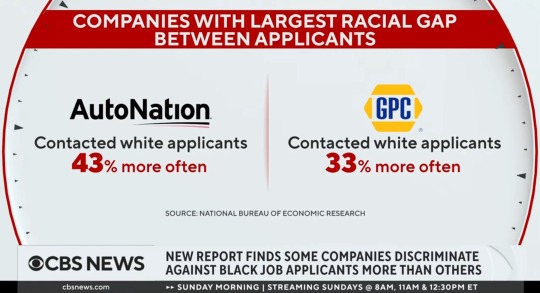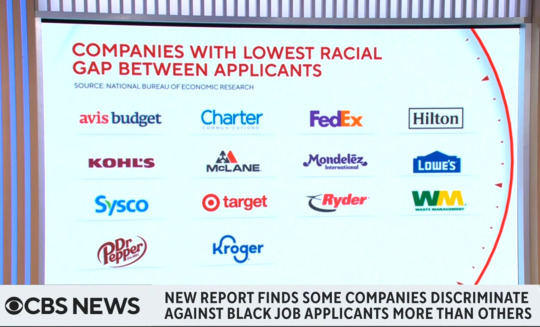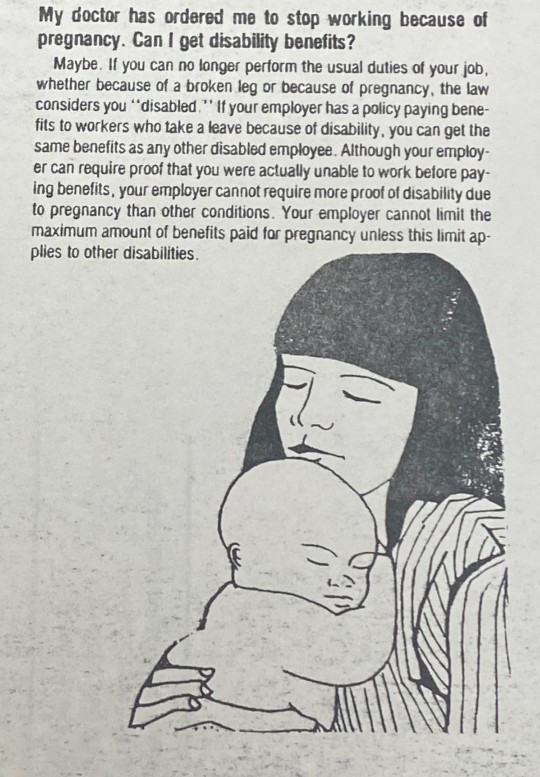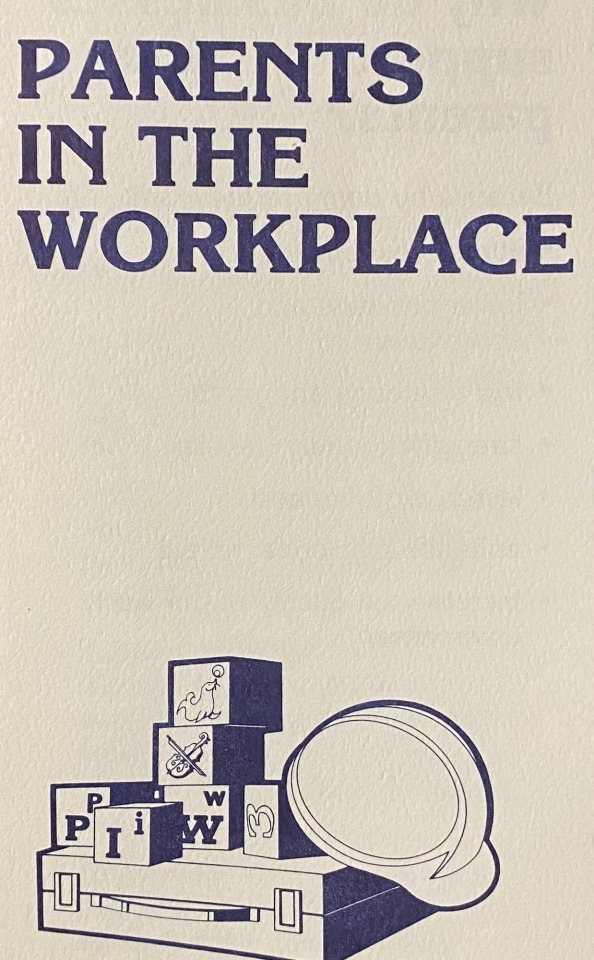#Employment Discrimination
Text
youtube




#we been knew study#employment discrimination#anti blackness#National bureau of economic research#a discrimination report card#Evan rose#cbs#youtube#video#no image description
7 notes
·
View notes
Text
"Writing for The Guardian, Cathy O'Neil, the American data scientist and author of Weapons of Math Destruction, explains how online tech-hiring platform Gild (which has now been bought and brought in-house by investment firm Citadel) enables employers to go well beyond a job applicant's CV, by combing through their 'social data'. That is, the trace they leave behind them online. This data is used to rank candidates by 'social capital' which basically refers to how integral a programmer is to the digital community. This can be measured through how much time they spend sharing and developing code on development platforms like GitHub or Stack Overflow. But the mountains of data Gild sifts through also reveal other patterns.
"For example, according to Gild's data, frequenting a particular Japanese manga site is a 'solid predictor of strong coding'. Programmers who visit this site therefore receive higher scores. Which all sounds very exciting, but as O'Neil points out, awarding marks for this rings immediate alarm bells for anyone who cares about diversity. Women, who as we have seen do 75% of the world's unpaid care work, may not have the spare leisure time to spend hours chatting about manga online. O'Neil also points out that 'if, like most of techdom, that manga site is dominated by males and has a sexist tone, a good number of the women in the industry will probably avoid it'. In short, Gild seems to be something like the algorithm form of the male computer-science teacher from the Carnegie programme.
"Gild undoubtedly did not intend to create an algorithm that discriminated against women. They were intending to remove human biases. But if you aren't aware of how those biases operate, if you aren't collecting data and taking a little time to produce evidence-based processes, you will continue to blindly perpetuate old injustices. And so by not considering the ways in which women's lives differ from men's, both on and offline, Gild's coders inadvertently created an algorithm with a hidden bias against women.
"But that's not even the most troubling bit. The most troubling bit is that we have no idea how bad the problem actually is. Most algorithms of this kind are kept secret and protected as proprietary code. This means that we don't know how these decisions are being made and what biases they are hiding. The only reason we know about this potential bias in Gild's algorithm is because one of its creators happened to tell us. This, therefore, is a double gender data gap: first in the knowledge of the coders designing the algorithm, and second, in the knowledge of society at large, about just how discriminatory these AIs are."
Excerpt from Invisible Women by Caroline Criado Perez, 2019.
#employment discrimination#job hunting#job market#techblr#techspo#csblr#misogyny#women in tech#radical feminist community#initially reading this shocked me bc we techies never name platforms and services like Gild directly. too risky.
4 notes
·
View notes
Photo




Now processing: the papers of Professor Laura J. Cooper, who was heavily involved in the implementation of anti-discrimination procedures at the U of M in the wake of the Rajender Consent Decree.
These pamphlets from the National Lawyers Guild, Parents in the Workplace, and the Council on the Economic Status of Women have the best illustrations.
#university of minnesota#umn#umn law#minnesota law#rajender#laura cooper#employment law#maternity leave#pregnant employees#pamphlets#1980s#sex-based discrimination#riesenfeld center#archives#archival processing#employment discrimination#higher education#minnesota history#women's rights#national lawyers guild#legal advocacy#illustrations
43 notes
·
View notes
Text
“Atheists Have Nothing to Complain About” (12/?)
North Carolina, US - Fall of 2020
An atheist construction worker was fired after refusing to attend his company’s required Christian prayer meetings (which also involved Bible readings and roll call) in North Carolina.
This came after his pay was cut in half.
This comes after another worker, a customer service representative, was fired in January 2021 after she felt the meetings, which went on for nearly an hour, were becoming “cult-like” and stopped attending due to her agnostic beliefs.
#atheists#religious persecution#christianity#christian news#abrahamic religions#religion#atheism#did you know#the bible#employment#employment discrimination#little known fact#north carolina#united states#american news#atheist news#atheist persecution#the united states#the united states of america#us of a#usa news#prayer
33 notes
·
View notes
Text
This unanimous Supreme Court decision is getting very little press coverage, but it's really great news and it's important for people to know about because there is a new way in which workers are now protected from discrimination, so if this applies to you, it's valuable to know your rights here have increased.
This ruling overturns a decision that ruled that job transfers are not "significant" enough to prove damages in an employment discrimination case.
This is a critically important ruling because often, in cases involving biases like sexism, racism, or retaliation against whistleblowing, authority figures will use transfers to punish workers without legal consequences. I.e. instead of firing or demoting someone, they will transfer them into a position they find boring or unpleasant, and/or that has few or no opportunities for advancement.
Now, employees are opened up to show other types of damage and file Title VII lawsuits for discrimination in these cases. The employee still has to demonstrate some type of harm, but the ruling makes it so that their concerns cannot be categorically dismissed just because they were not given a pay cut. Things like the unpleasantness of the job and opportunities for advancement are now valid reasons for filing suit.
This sort of situation is particularly common in municipal government bureaucracies and other unionized employers, where administrators use transfers as a way of getting around grievance processes or restrictions, but the ruling applies to all private employers.
1 note
·
View note
Text
Combating Federal Employee Discrimination A guide to Proving Your Claim
youtube
1 note
·
View note
Text
Big moments for women at the men's World Cup | CNN Politics
Big moments for women at the men’s World Cup | CNN Politics
A version of this story appears in CNN’s What Matters newsletter. To get it in your inbox, sign up for free here.
CNN
—
An unexpected result of the US Men’s National Team reaching the knockout round of 16 at the FIFA World Cup in Qatar is that the US Women’s National Team will get its largest collective payday, equally splitting $13 million in winnings with the men.
It’s a big deal for…

View On WordPress
#2022 FIFA World Cup#brand safety-nsf discrimination#brand safety-nsf sensitive#compensation and benefits#continents and regions#demographic groups#discrimination#domestic alerts#domestic-international news#domestic-us news#domestic-us politics#employment discrimination#females (demographic group)#fifa#FIFA Women&x27;s World Cup#FIFA World Cup#football (soccer)#iab-soccer#iab-sports#international alerts#international-us news#international-us politics#Iran#labor and employment#Middle East#middle east and north africa#north america#pay gap#population and demographics#Qatar
0 notes
Link
39 notes
·
View notes
Text
being asked pronouns in professional settings is really just like "do you really think I'm going to let you attribute to men or assumed-men-as-default *all* of my contributions?" be fr.
5 notes
·
View notes
Text
What is a Hostile Work Environment in California?
Most people can generally say that they have worked jobs with unpleasant bosses and unfriendly coworkers. But when negative behavior crosses the line into discrimination and harassment to a degree that becomes abusive or intimidating and makes it impossible for someone to do their job, it may be considered a hostile work environment. It is important to know what steps to take and what options and legal protections you have if you find yourself in such a situation.
What is the Definition of Hostile Work Environment?
Just because there is a negative work environment, does not necessarily mean there is a hostile work environment. However, there are several factors involved in determining if a hostile work environment is present:
Discrimination of a protected class
Offensive conduct
Threats and/or intimidation
Physical and/or mental abuse
Hinders the employee’s ability to do their job
Employers are not only liable for creating a hostile work environment, they are also liable if they allow it to occur. There are both state and federal laws that combat employment harassment and discrimination including hostile work environments. California law determines that a hostile work environment is present if there is severe or pervasive abusive conduct.
What are Considered Criteria for a Hostile Work Environment?
In order to determine if a situation constitutes a hostile work environment, it is important to ask the following questions:
Is conduct discriminatory or retaliatory against a protected class or action?
Is the conduct ongoing and constant?
Would a reasonable person feel the conduct creates a hostile or abusive environment?
Has the victim’s ability to do their job been negatively affected?
Did the employer know or reasonably should have known about the situation?
Did the employer fail to take action to stop the abusive conduct?
What Is Not Considered a Hostile Work Environment?
Just because there are factors present that create an abusive work environment, that does not mean it is considered hostile under the definition of the law. Many situations may be unfair or upsetting, but are not illegal, such as:
An employer showing favoritism with no discrimination against a protected class
Coworkers ostracizing an employee because they don’t like their personality
An employer who yells at everyone and is always rude to all employees
A coworker making an insulting comment once
An employer making new employees do the worst job duties
What Constitutes a Hostile Work Environment in California?
The following patterns of behavior are enough to make a workplace a hostile environment.
When Hostile Behavior Becomes Discriminatory
Both federal and state laws protect employees from workplace discrimination. A hostile work environment can occur when discrimination becomes pervasive and severe enough to negatively impact the employee’s ability to work. Categories protected from discrimination include:
Age – Workers who are forty or older are protected from discrimination.
Disabilities – Workers with physical or mental impairments or illnesses are also protected from discrimination. Conditions are generally chronic and limit major life activities such as:
Sensory impairment
Paralysis
Cerebral Palsy
Diabetes
Missing limbs
Clinical depression
Autism
ADHD
PTSD
Schizophrenia
Genetic Information – Employers are prohibited from collecting genetic information from their employees or using that information against them. This includes testing and family histories of diseases.
Medical Conditions – Characteristics associated with diseases or health issues related to cancer are also protected under anti-discriminatory laws. Employees do not need to be actively experiencing symptoms in order to be protected.
Race – Not only is it illegal to discriminate against someone for their race, color, ancestry, or national origin, but it is also illegal to discriminate against someone due to the race of the people they associate with. Workers are also protected against being discriminated against for being perceived as a race that is not their own. Things like racial slurs, offensive jokes, and derogatory comments are prohibited.
Religion – Employers are prohibited from discriminating against employees for their religious beliefs or practices. This may include harassing someone with slurs and stereotypes or refusing to allow someone to take time off to observe holidays.
Sex – Sex based discrimination covers a wide range of categories in addition to biological sex.
Gender – Discrimination against someone for their gender identity or presentation is prohibited regardless of their biological sex.
Sexual Orientation – It is illegal to harass or discriminate against employees for their sexual orientation or perceived sexual orientation.
Pregnancy – Employers cannot discriminate against an employee who is pregnant, experiencing complications of pregnancy or childbirth, an employee who is breast feeding, or an employee who could become pregnant.
Sexual Harassment – Sex based discrimination includes unwanted and offensive conduct that is of a sexual nature including comments, jokes, invasive questions, unwelcome sexual advances, and threats.
Toxic Work Environment
A toxic environment can be an early warning sign that a work environment may become hostile. When observing toxic behavior in the workplace concerning discrimination, harassment, bullying, hostility, or insults it is important to keep a record of everything. Be as specific as possible regarding dates and times, who said what, and who was present. It is also usually a good idea to report these things to human resources or upper management in writing and via email if possible.
Consistent Hostile Behavior in the Workplace
Generally speaking, minor isolated incidents do not constitute unlawful harassment or a hostile work environment. The EEOC requires that the harassing conduct in question be pervasive and severe in order to qualify. What they describe as “petty slights, annoyances, and isolated incidents” do not count on their own. Smaller incidents should still be documented, however. Keeping detailed records is one of the best ways to prove that the behavior is consistent. Discriminatory or harassing behavior should also be reported to management or human resources.
Inappropriate Behavior Becomes Aggressive
Hostile behavior in the workplace is usually aggressive. This can be physical or verbal in nature such as intimidation, yelling, insults, or general cruelty. Aggressive behavior and bullying in general are not always proof of a hostile work environment, but they are a factor. When physical aggression is involved, the most important thing is everyone’s safety. Try to deescalate or remove yourself from the situation and report the incident.
Hostile Behavior Disrupts the Ability to Work
One major way to know that a work environment has become hostile is when it begins interfering with your ability to do your job. Consistent aggressive behavior can make it impossible to concentrate on the tasks at hand. Discrimination and sabotage can also make it impossible to advance your career further. The matter should be reported to human resources via email, and it may be time to contact the EEOC and consult with an employment attorney.
Hostile Work Environment Requires a Formal Complaint
Most companies have their own guidelines and procedures for reporting and addressing discrimination, harassment, and hostile work environments. If you have an employee handbook, it should be outlined there. It is always important to be sure that you have made a formal written complaint and given your employer the opportunity to address and remedy the situation. It is also good practice to be sure that you retain a copy of the complaint and proof that you submitted it. If your employer does not take action, you may want to explore your legal options.
Signs of Hostile Work Environment
There are many elements that create a hostile work environment and many signs that this may be what you are experiencing. Some things to look out for include:
Discrimination – Slurs, jokes, and derogatory comments made about someone’s age, race, religion, gender, sex, orientation, or disability.
Images – Pictures and symbols including photographs and drawings that are offensive or threatening being displayed in the workplace or posted or sent online.
Sexual harassment – Jokes, comments, and questions of a sexual nature, propositions, requests for sexual favors, threats, and unwanted physical contact that a reasonable person would find offensive.
Bullying – Insults, jokes, pranks, derogatory comments, and ostracization in the office, online, and at work sponsored social functions.
Sabotage – Ruining someone’s work or reputation, setting them up to fail, or holding them to impossible standards or higher standards than everyone else.
Intimidation – Physical or verbal threatening behavior such as blocking someone’s path, shouting at them, or standing in their personal space.
Touching – Unwanted physical contact that would reasonably be considered uncomfortable. Even “harmless” touching if the person is asked to stop and does not.
Favoritism – Employers granting perks, benefits, and promotions to select employees and not others based on personal preference. This is unlawful if it is based on protected characteristics.
Minor offenses – Some things such as isolated incidents and general unpleasantness that would not be enough to warrant a hostile environment on their own but these can pile up and supplement other problematic behaviors.
Am I Experiencing a Hostile Work Environment?
Just because a work environment is bad, does not necessarily mean that it is hostile by legal definition. Employers do not have a responsibility to provide an emotionally healthy and positive work environment. Being a generally terrible boss is not illegal on its own. The law considers a work environment to be hostile when that hostility is motivated by discrimination against protected characteristics. When trying to determine if you are experiencing a hostile work environment, consider the following:
Is the boss mean to all of the employees, or only people belonging to certain groups?
Is there personal favoritism, or are specific types of people shown special treatment?
Is the employer only hiring or firing certain types of people?
Are the negative comments being made about specific types of people?
Have there been one or two incidents or is there a consistent pervasive problem?
Reporting a Hostile Work Environment
If an employee is experiencing a hostile work environment, the first step is to file a detailed complaint with their employer. This complaint should be made in writing and sent via email to the human resources department. If there is no human resources department, the complaint should be filed with upper management. If the employer does not take action to resolve the issue, then the employee can file a complaint with the California Department of Fair Employment and Housing. The DFEH may investigate the matter and try to resolve it on their own or issue the employee a right to sue letter. At this point, the employee may file a lawsuit against their employer.
How to Prove a Hostile Work Environment?
One of the best ways to prove a hostile work environment is through documentation. Having a detailed timeline of events and proof that the issue was brought to the employer’s attention. Retain copies of all complaints and email or text conversations regarding the situation including any correspondence that illustrates the discrimination or harassment. Witness testimony is another important piece of evidence. Sometimes coworkers can attest to having seen and heard the hostile treatment firsthand.
Employers Responsibilities When Discovering a Hostile Work Environment
When there is a hostile environment in the workplace, it is the employer’s responsibility to respond quickly and effectively. There are several steps an employer can take to appropriately address the issue:
Listen – Employers should always take complaints seriously. Do not disregard or brush off employee concerns or assume they are overreacting. Pay attention to what they are saying and gather all the information necessary. If the employee is concerned for their wellbeing, find a way to remove them from the situation in a way that is not punishing them for coming forward. Let them know that you hear them and that you are taking the matter seriously.
Investigate – A thorough and impartial investigation should be conducted with as much confidentiality as possible. The company can have an internal investigation procedure or bring in a third party. The investigator should look into all the facts of the situation including conducting individual interviews with the accuser, the accused, and any possible witnesses. The employer should take all of the information collected into consideration to be sure that a fair and reasonable judgment is made.
Communicate – All parties involved should be updated as to the results of the investigation. A written correspondence should be issued in a timely manner declaring that either the harassment was confirmed, or that it could not be confirmed.
Take Action – If the investigation confirms the employee’s complaints, the employer has a responsibility to act. The guilty party should face appropriate disciplinary action be it a write up, suspension, or termination depending on the severity of the situation and the company’s anti-harassment policies. If the punishment is not termination or harassment cannot be confirmed, it may still be appropriate to reassign one of the parties so that they are no longer required to interact. It is important to be certain that any action taken does not also punish the victim. Regardless of the outcome, it may be necessary to review and update the company’s policies and training regarding harassment and discrimination prevention to prevent further incidents.
Ways to Prevent a Hostile Work Environment
The state of California has laws and guidelines in place to ensure that employers are taking action to prevent workplace harassment and hostile work environments.
All employers are expected to have written company policies addressing harassment, discrimination, and retaliation prevention. These policies must be provided to all employees and include:
A list of all of the categories protected under the FEHA
A reminder that coworkers, management, supervisors, and third parties are prohibited from engaging in unlawful practices
A process for filing complaints beyond the employee’s immediate supervisor
A reminder to supervisors to report any complaints to HR or designated representatives
An assurance that complaints will be investigated in a timely, thorough, and fair manner
An assurance that confidentiality will be kept as much as is possible
An assurance that action will be taken if the investigation confirms misconduct
An assurance that employees will not face retaliation for filing complaints or participating in an investigation
There is also literature created by the DFEH such as a sexual harassment brochure and an information sheet that should be provided to employees. The DFEH’s anti-discrimination and harassment posters must also be posted somewhere that is prominent and accessible to all employees.
Employers in the state of California with five or more employees must provide all employees in California with sexual harassment prevention training every two years. Supervisory staff must undergo two hours of training while nonsupervisory staff must undergo one hour of training. The training must include:
An understanding of state and federal laws
Ways to prevent and respond to abusive conduct
Practical examples of discrimination, harassment, and retaliation
Remedies available to those facing workplace harassment
Ways to prevent and respond to general workplace bullying
Recent laws also added that other sex-based harassment such as gender identity and presentation, transgender status, and sexual orientation also be covered in mandated training.
Contact Mesriani Law Group If You Are Experiencing a Hostile Work Environment
Being in a hostile workplace can take enough of a toll on a person without the added stress of filing a lawsuit. If all other options have been exhausted and it is time to take legal action, it may be best to seek the help of an employment attorney. A lawyer can help guide you through the process and fight for your best interests. Facing discrimination and harassment in the workplace is something that no one should have to go through alone. Our attorneys are hardworking, experienced, and dedicated to getting our clients the compensation they deserve. If you have been the victim of a hostile work environment, call Mesriani Law Group today for a free consultation.
Hostile Work Environment FAQs
What qualifies as a hostile work environment?
When discriminatory and harassing behavior becomes so pervasive and constant that it negatively impacts an employee’s ability to do their job, then it may be considered a hostile work environment. The offensive behavior must be motivated by discrimination based on a protected characteristic such as age, race, religion, sex, gender, sexual orientation, disabilities, or as retaliation for whistleblowing.
How do you prove you are in a hostile work environment?
One of the best ways to prove a hostile work environment is through documentation. Keep copies of any correspondence or documents that show discrimination or harassment. Make detailed written complaints sent to human resources via email. Create a timeline of events detailing exactly what happened, when it happened, and who was involved. It is also extremely beneficial to have eyewitness testimony as well if possible.
What four factors contribute to a hostile work environment?
Creating a hostile work environment includes many aspects and details. While every situation is different, the main determining factors that define a hostile work environment are:
• Discrimination against a protected class or retaliation against a protected action
• Conduct that any reasonable person would find abusive
• Conduct that is pervasive and consistent
• The victim is unable to perform their job due to the conduct
What are the signs of a toxic workplace?
There are many early warning signs that a work environment has become toxic:
• A lack of morale among employees
• Abusive or aggressive employers
• Unchecked harassment among coworkers
• Unfairly high standards and harsh reprimands for not meeting them
• Uneven workloads
• Favoritism and nepotism
• A high number of stress induced health issues
#California Employment Law#Hostile Work Environment#Workplace Discrimination#Workplace Harassment#Employment Discrimination#Toxic Work Environment#Employment Law#Employment Lawyers#California Attorneys
0 notes
Text
yo if anybody's well-versed in the ADA & its applications PLEASE hmu
#ADA#americans with disabilities act#ADA discrimination#employment discrimination#disability rights#I mean im mostly trying to find out if my interview process was legally ok and if it can impact my boss possibly firing me
0 notes
Photo

“Sault Ste. Marie, Ont., May 6. - Discrimination against ex-service men in favor of alien labor is charged by the members of the Canadian Legion against Soo industries here and every member of the veterans’ organization has been asked to report to the legion secretary on the number of foreigners employed in his own trade.”
- from the Toronto Star. May 6, 1932. Page 3.
#sault ste. marie#employment discrimination#xenophobia in canada#canadian legion#ex-servicemen#returned soldiers#canadian veterans in politics#capitalism in canada#canadian veterans#immigration to canada#dangerous foreigners#reactionary politics#great depression in canada
0 notes
Text
Feminism gave us laws against job discrimination based on gender; immediately case law evolved in Britain and the United States that institutionalized job discrimination based on women’s appearances. Patriarchal religion declined; new religious dogma, using some of the mind-altering techniques of older cults and sects, arose around age and weight to functionally supplant traditional ritual. Feminists, inspired by Friedan, broke the stranglehold on the women’s popular press of advertisers for household products, who were promoting the feminine mystique; at once, the diet and skin care industries became the new cultural censors of women’s intellectual space, and because of their pressure, the gaunt, youthful model supplanted the happy housewife as the arbiter of successful womanhood. The sexual revolution promoted the discovery of female sexuality; “beauty pornography”—which for the first time in women’s history artificially links a commodified “beauty” directly and explicitly to sexuality—invaded the mainstream to undermine women’s new and vulnerable sense of sexual self-worth. Reproductive rights gave Western women control over our own bodies; the weight of fashion models plummeted to 23 percent below that of ordinary women, eating disorders rose exponentially, and a mass neurosis was promoted that used food and weight to strip women of that sense of control. Women insisted on politicizing health; new technologies of invasive, potentially dangerous “cosmetic” surgeries developed apace to re-exert old forms of medical control of women.
— The Beauty Myth (Naomi Wolf)
#book quotes#naomi wolf#the beauty myth#feminism#misogyny#employment#employment discrimination#religion#housework#economics#capitalism#advertising#dieting#weight#reproductive rights#abortion#health#medicine#cosmetic surgery#beauty#beauty pornography
1 note
·
View note